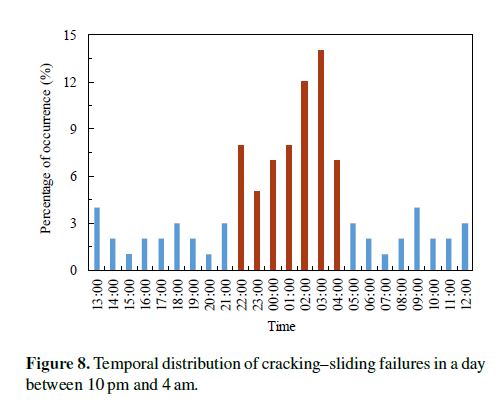30 April 2018
A surprising but important discovery on the timing of cracking-sliding failures landslides in China
Posted by Dave Petley
A surprising but important discovery on the timing of “cracking-sliding failures” loess landslides in China
An interesting study has recently been published in the journal Natural Hazards and Earth System Science (Li et al. 2018 – available open access) that looks at, amongst other things, the timing of loess landslides in China. The paper presents an analysis of a dataset of what are termed as “cracking-sliding failures of loess” on the eastern Huangtu Plateau – often known as the Loess Plateau – in China. I haven’t heard of the term “cracking-sliding failure” previously, but in essence these are loess landslides that develop as a result of initial tensile failure, allowing sliding to develop. Li et al. (2018) point out that these landslides cause high levels of loss, noting that there have been over 1000 landslides of this type on China in the last two decades, causing an average of over 100 fatalities per annum.
The authors have compiled a database of 1176 cracking-sliding failures in a part of the Loess Plateau, all of which have occurred in the last 20 years. They have then looked in detail at the timing of failure – one part of the analysis examines the annual cycle of landslides. This diagram, from the paper, presents the annual cycle of cracking-sliding failures:

The annual cycle of cracking-sliding failures on the Loess Plateau in China. Figure from Li et al. (2018)
.
In general, the annual cycle closing matches the seasonality of rainfall, as expected. But note the secondary peak in March and April – this is interpreted as being the result of the rise in temperatures in the spring, when the upper portion of the frozen layer starts to thaw. They hypothesise that this thawing process drives both frost heave and weakening of the soil through a collapse of the pore structure.
Even more interesting is the time of day in which the landslides occurred:-

The time of day in which cracking-sliding failures occurred on the Loess Plateau. Figure from Li et al. (2018)
.
The data suggest that the failures occur preferentially in period between 10 pm and 5 am. The authors do not really explain why this should be the case, other than noting that there is a huge temperature change through the daily cycle, which drives thermal expansion and contraction, which might in turn drive weakening. I am not convinced by this explanation, given that most of the failures are driven by rainfall. Does the heaviest rainfall happen at night? But I think this daily cycle is a fascinating finding, which needs further research.
Of course 10 pm to 5 am is the very worst time for landslides to occur from a human perspective. The combination of darkness and the likelihood of people being asleep inevitably drives high levels of loss.
Reference
Li, Y., Mao, J., Xiang, X., and Mo, P. 2018 Factors influencing development of cracking–sliding failures of loess across the eastern Huangtu Plateau of China, Natural Hazards and Earth System Sciences, 18, 1223-1231, https://doi.org/10.5194/nhess-18-1223-2018.


 Dave Petley is the Vice-Chancellor of the University of Hull in the United Kingdom. His blog provides commentary and analysis of landslide events occurring worldwide, including the landslides themselves, latest research, and conferences and meetings.
Dave Petley is the Vice-Chancellor of the University of Hull in the United Kingdom. His blog provides commentary and analysis of landslide events occurring worldwide, including the landslides themselves, latest research, and conferences and meetings.
Hi Dr. Petley, I am a big fan of your blog! I read a paper recently by Schulz et al (2009) that relates atmospheric tides to the speed at which a deep seated landslide is moving (Slumgullion landslide). What are your thoughts on the effect of atmospheric pressure and how that affects the subsurface movement of water and sediment?
[Hi Becky, thanks for your comment and for your kind words. This fine piece of research certainly caused a stir when it was published. I think it is one of the most significant results in terms of landslides of the last decade. It showed us that in systems that are delicately balanced close to equilibrium with an FoS that varies around one minor pressure changes affect movement rate. I don’t think we realised that systems could be so sensitive until that point. I suspect that Slumgullion is comparatively unusual (though not unique) though, and in most other systems other effects probably drown out that signal. We certainly didn’t see the same effects at Taihape and Utiku for example. I am interestied in what you think? D.]